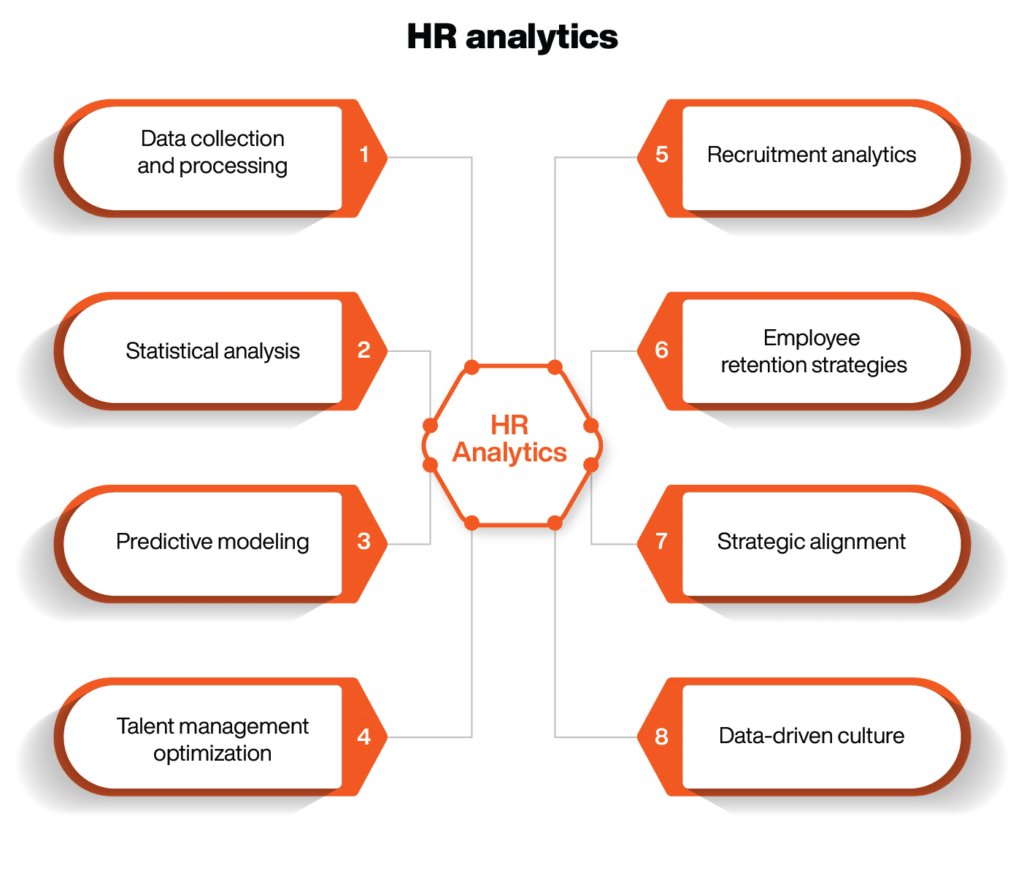HR Analytics, a pivotal tool in modern Human Resources management, involves the systematic analysis of workforce data that helps in strategic decision-making. HR professionals should prioritize learning HR analytics due to its transformative impact on organizational effectiveness. Mastery of HR analytics equips professionals to align HR strategies with business goals, optimize recruitment processes, and identify key performance indicators. This skill set not only enhances problem-solving capabilities but also positions HR practitioners as integral contributors to organizational success.
In an era where data-driven insights drive competitive advantage, adopting HR Analytics in MBA Human Resource Management is indispensable for career progression, allowing professionals to navigate the complexities of workforce management with precision and strategic foresight. This post seeks to explain the various aspects of HR Analytics, emphasizing its inherent worth and underlining why HR professionals should embrace and become experts in this groundbreaking field.
Also Read: 10 important scope of Human Resource Management
What is HR Analytics?
HR Analytics is the strategic use of data and statistical methods to analyze and interpret information related to the workforce. Making informed choices requires gathering and analyzing data on a range of HR KPIs, including hiring, performance reviews, and employee engagement. HR experts can predict future outcomes and pinpoint areas for development by employing advanced analytics to identify trends, correlations, and patterns within data.
The usage of evidence-based approaches not only improves decision-making procedures but also enhances the overall efficacy of HR strategies. So, understanding HR Analytics within MBA HRM is crucial for organizations to optimize their human capital management and align HR practices with broader business objectives.
Read more: how to get a job in HR without work experience?

What do you learn in HR analytics?
The importance of HR Analytics in MBA HRM studies cannot be overlooked. In the field of HR analytics, individuals develop a comprehensive set of skills to harness the power of data and analytics for informed decision-making within the human resources domain. This involves a multifaceted approach encompassing various stages of data utilization.
- Data collection and processing: HR analysts learn to gather relevant data from diverse sources within the organization, including employee records, performance metrics, and engagement surveys. They focus on ensuring data accuracy, cleanliness, and security.
- Statistical analysis: Proficiency in statistical methods is crucial. HR professionals delve into descriptive and inferential statistics to derive meaningful insights from raw data. This step involves identifying patterns, trends, and correlations within the workforce data.
- Predictive modeling: HR analytics goes beyond retrospective analysis by incorporating predictive modeling techniques. This involves using statistical algorithms to forecast future trends and behaviors, aiding in workforce planning and strategic decision-making.
- Talent management optimization: HR analytics plays a pivotal role in enhancing talent management strategies. By analyzing historical and current data, professionals can identify high-performing employees, anticipate skill gaps, and implement targeted development programs.
- Recruitment analytics: Understanding the effectiveness of recruitment efforts is a core aspect. HR analytics enables the evaluation of recruitment channels, assessment of candidate quality, and optimization of hiring processes through data-driven insights.
- Employee retention strategies: Through data analysis, HR professionals can identify factors influencing employee turnover and job satisfaction. This allows for the development of tailored retention strategies to foster a more engaged and satisfied workforce.
- Strategic alignment: HR analytics is not merely about data manipulation; it is about aligning HR initiatives with broader business objectives. Professionals in this field learn to articulate the impact of HR strategies in the language of key performance indicators, which is highly useful as a metric for overall assessment of business outcomes.
- Data-driven culture: Creating a data-driven culture in the HR department and the entire company is an essential competency. This involves effective communication of insights, fostering collaboration, and encouraging decision-makers to rely on data when making HR-related choices.
How does HR Analytics help HR professionals advance their career
HR Analytics serves as a linchpin for HR professionals seeking career advancement. By delving into data, these professionals can proactively shape strategic workforce plans, ensuring alignment with organizational goals. Talent acquisition benefits from data-driven insights, allowing HR to optimize recruitment processes and enhance candidate experiences. Employee engagement receives a boost as analytics inform targeted initiatives, addressing satisfaction and retention challenges. Learning and development efforts become more effective as data guides the tailoring of programs to address specific skill gaps. Additionally, performance management processes benefit from a comprehensive view of individual and team metrics, promoting continuous improvement.
HR Analytics empowers professionals to contribute substantiated insights, enhancing their influence in organizational decision-making. As a result, HR professionals adept in analytics not only improve HR functions but position themselves as indispensable strategic partners, driving organizational success.
Check out: Why is an MBA in HR a top choice for many students
What are the key HR Analytics metrics?
HR analytics empowers professionals to move beyond traditional HR practices, leveraging data as a strategic asset. It transforms HR from a reactive to a proactive function, contributing significantly to organizational success by optimizing workforce management and aligning human capital strategies with overall business goals. The key HR Analytics metrics are:
- Employee Turnover Rate:
The Employee Turnover Rate is a crucial metric that delves into the percentage of employees who have left the organization within a specific time frame. This goes beyond mere numerical representation, offering a nuanced understanding of the reasons behind employee exits. Analyzing turnover trends can unveil insights into potential issues related to workplace culture, leadership effectiveness, or dissatisfaction, allowing for targeted interventions.
- Time to Fill Positions:
Time to Fill Positions measures the efficiency of the recruitment process by quantifying the average duration it takes to fill open positions. A comprehensive analysis of this metric involves dissecting each stage of recruitment, from job posting to final offer acceptance. Prolonged vacancy periods can impact team dynamics, increase workloads for existing staff, and potentially result in missed business opportunities.
- Employee Productivity:
Employee Productivity transcends basic output metrics, focusing on the quality and efficiency of work. This metric involves a multifaceted evaluation of individual and team contributions, considering factors such as project completion rates, task efficiency, and overall impact on organizational goals. Identifying high-performing teams and individuals enables targeted recognition and support, contributing to sustained productivity levels.
- Absenteeism Rate:
The Absenteeism Rate is a key metric reflecting the frequency and patterns of employee absences. Beyond the numerical aspect, a detailed analysis involves identifying trends, patterns, and potential correlations with workplace factors. Consistently high absenteeism may signal underlying issues such as burnout, dissatisfaction, or health concerns, necessitating a holistic approach to improve employee well-being.
- Cost per Hire:
Cost per Hire extends beyond the financial investment in recruitment, encompassing the entire spectrum of expenses incurred during the hiring process. This includes recruitment marketing, interview costs, onboarding expenses, and more. A thorough understanding of these costs enables organizations to optimize their recruitment strategies, allocate budgets efficiently, and enhance the overall effectiveness of the talent acquisition process.
- Employee Satisfaction and Engagement:
Employee Satisfaction and Engagement metrics involve comprehensive surveys and feedback mechanisms to gauge the holistic well-being of the workforce. This goes beyond surface-level assessments, diving into factors influencing job satisfaction, collaboration, and overall engagement levels. Actionable insights derived from these metrics empower organizations to tailor initiatives that enhance the workplace experience, ultimately fostering a positive and engaging culture.
- Training ROI (Return on Investment):
Training ROI evaluates the effectiveness of training programs by assessing the tangible impact on employee performance and, by extension, organizational success. Beyond mere participation metrics, a detailed analysis involves connecting training outcomes with key performance indicators. This ensures that training initiatives align with strategic business goals, contribute meaningfully to skill development, and deliver a measurable return on investment.
- Diversity and Inclusion metrics:
A variety of indicators are included in diversity and inclusion metrics, such as diversity in leadership positions, inclusion scores, and representation ratios. Businesses can assess the success of their diversity and inclusion programs, thanks to this all-inclusive approach. Maintaining a continuous commitment to establishing a workplace that values diversity and inclusion at all levels requires regular monitoring of these measures to assess success and uncover areas for improvement.
Check out: How an MBA prepare you for various HR functions
Learn HR Analytics with an online MBA in HR from MAHE
Discover unparalleled opportunities for professional growth with the Online MBA in HR from Manipal Academy of Higher Learning (MAHE). This program is meticulously crafted to empower HR professionals by delving into advanced HR subjects, with a distinct focus on HR Analytics. The Online Manipal (OM) platform, renowned for its user-friendly interface, offers a flexible and engaging learning experience.
Participants benefit from an industry-relevant curriculum designed by seasoned experts, gaining insights that bridge theory and practical application. MAHE’s commitment to academic excellence ensures that graduates emerge not only well-versed in HR Analytics but also equipped with leadership and strategic skills crucial for success in today’s competitive landscape. So, elevate your HR expertise and career prospects with MAHE’s online MBA, where innovation meets the evolving needs of the dynamic field of Human Resources.
Also Read: MBA HR course details: A complete guide
Prepare for your next career milestone with us













